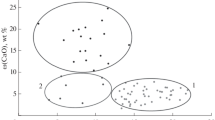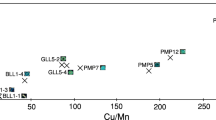Abstract
In this article, the chemical and mineralogical composition of a unique glass cylinder obtained from the temple of Chogha-Zanbil and classified as the earliest glass discovered in Iran (2nd millennium BC) has been studied. This was achieved through the use of Fourier transform infrared spectroscopy, environmental scanning electron microscope and synchrotron X-ray micro-diffraction to characterize the presence of microstructures and the distribution of elements within their matrices. In order to accurately determine the characteristic crystalline phase constituents, micro-X-ray diffraction experiments were carried out at the CELLS-ALBA Synchrotron. Results reveal that the glass samples are comprised of silica glass and contain calcite, quartz and gehlenite as the major phases. The presence of argentojarosite as the Ag-bearing mineral within the amorphous part of glasses highlights the first use of Ag (Late Bronze Age) in Iran. The novelty of the results includes the identification of specific minerals (i.e., silver-containing minerals) used in the production of glass cylinders to obtain better luster and produce iridescence effects.









Similar content being viewed by others
This manuscript has associated data in a data repository. [Authors’ comment: The datasets generated during and/or analysed during the current study are available in the Mohammadamin Emami repository, DOI : https://doi.org/10.1140/epjp/s13360-020-00486-6.].
References
E. Gliozzo, M. Turchiano, F. Giannetti, I. Memmi, Archaeometry 58, 113 (2016)
L. Dussubieux, C.M. Kusimba, V. Gogte, S.B. Kusimba, B. Gratuze, R. Oka, Archaeometry 50(5), 797 (2008)
M. Emami, S. Nekouei, H. Ahmadi, C. Pritzel, R. Trettin, Int. J. Appl. Glass Sci. 7(1), 59 (2016)
J. Henderson, Acc. Chem. Res. 35(8), 594 (2002)
I. Freestone, Looking into glass, in Science and the Past, ed. by S. Bowman (De Gruyter, 1991), pp. 37–56
A. Cholakova, T. Rehren, I.C. Freestone, J. Archaeol. Sci. Rep. 7, 625 (2016)
D. Brems, P. Degryse, Archaeometry 56, 116 (2014)
S.C. Rasmussen, How Glass Changed the World (Springer, Berlin, 2012), p. 11
J. Henderson, Oxf. J. Archaeol. 4(3), 267 (1985)
T. Rehren, J. Archaeol. Sci. 38(12), 3694 (2011)
R.H. Brill, B.A. Rising, in Chemical Analyses of Early Glasses. Vol. 1: Catalogue of Samples. Vol. 2: Tables (The Corning Museum of Glass, Corning, New York, 1999)
I. Freestone, in Early Vitreous, Materials, vol. 56, ed. by M. B. a. I. F. (British Museum Occasional Paper, 1987), pp. 173
R. Ghirshman, Archaeology 8(4), 260 (1955)
J. Henderson, Archaeometry 30(1), 77 (1988)
J. Rius, A. Labrador, A. Crespi, C. Frontera, O. Vallcorba, J.C. Melgarejo, J. Synchrotron Radiat. 18(6), 891 (2011)
F. Fauth, I. Peral, C. Popescu, M. Knapp, Powder Diffr. 28(S2), S360 (2013)
S. Quartieri, Synchrotron Radiation (Springer, Berlin, 2015), p. 677
L. Bertrand, Methodological developments and support for synchrotron investigation in cultural heritage and archaeology, in Trends of Synchrotron Radiation Applications in Cultural Heritage, Forensics and Materials Science: Proceeding of a Technical Meeting, International Atomic Energy Agency, ISSN 1011–4289; no. 1803 (2016), pp. 48–60
M. Castro, F. Pereira, A. Aller, D. Littlejohn, Atmos. Environ. 98, 41 (2014)
A. Banerjee, Zeitschrift für Naturforschung A 48(5–6), 741 (1993)
J. Shuster, F. Reith, M.R. Izawa, R.L. Flemming, N.R. Banerjee, G. Southam, Minerals 7(11), 218 (2017)
J. Molera, T. Pradell, N. Salvadó, M. Vendrell-Saz, J. Am. Ceram. Soc. 82(10), 2871 (1999)
R. Di Febo, J. Molera, T. Pradell, O. Vallcorba, J.C. Melgarejo, C. Capelli, Eur. J. Mineral. 29(5), 861 (2017)
T. Pradell, J. Molera, N. Salvadó, A. Labrador, Appl. Phys. A 99(2), 407 (2010)
G. Harbottle, B. Gordon, K. Jones, Nucl. Instrum. Methods Phys. Res. Sect. B 14(1), 116 (1986)
M. Cotte, M. Radepont, E. Pouyet, M. Salome, and J. Susini, Synchrotron-based X ray and FTIR micro-spectroscopy for the cultural heritage science at the ID21 beamline, ESRF, in Proceeding of a Technical Meeting, International Atomic Energy Agency, ISSN 1011–4289; no. 1803 (2016) pp. 60–672
L. Maritan, L. Casas, A. Crespi, E. Gravagna, J. Rius, O. Vallcorba, D. Usai, Herit. Sci. 6(1), 74 (2018)
M. Maggetti, C. Neururer, D. Ramseyer, Appl. Clay Sci. 53(3), 500 (2011)
T. Pradell, J. Molera, G. Molina, M.S. Tite, Appl. Clay Sci. 82, 106 (2013)
T. Pradell, G. Molina, S. Murcia, R. Ibáñez, C. Liu, J. Molera, A.J. Shortland, Int. J. Appl. Glass Sci. 7(1), 41 (2016)
J. Dutrizac, Metall. Trans. B 14(4), 531 (1983)
R.B. Heimann, M. Maggetti, Scientific Studies in Ancient Ceramics, vol. 19 (British Museum Research Laboratory, London, 1981), p. 163
Acknowledgements
This work was funded by proposal ID 2017062250 at BL04-MSPD beamline, ALBA, Spain. This research has also been financially supported by the Ministry of Science, Research and Technology, and the Institute for Research in Fundamental Sciences (IPM), Tehran, Iran, in collaboration with ALBA Synchrotron, Barcelona, Spain. This project has been run and supported by Horizon 2020. The authors are sincerely thankful to the beamline scientists at BL04 – MSPD in ALBA synchrotron. Special thanks are expressed to Prof. Miguel Aranda, the scientific director of ALBA, for all his collaboration and help in this project. The authors gratefully appreciate Prof. Gabriela Krist, Universität für angewandte Kunst Wien/University of Applied Arts, Vienna, for allowing the corresponding author to cooperate with her department. Finally, we would like to thank two anonymous reviewers for their constructive comments to our manuscript, which helped to improve the final version of this article.
Author information
Authors and Affiliations
Corresponding author
Rights and permissions
About this article
Cite this article
Emami, M., Rozatian, A.S.H., Vallcorba, O. et al. Synchrotron micro-XRD study, the way toward a deeper characterizing the early prehistoric Iranian glass cylinders from Late Bronze Age (1280 BC). Eur. Phys. J. Plus 135, 487 (2020). https://doi.org/10.1140/epjp/s13360-020-00486-6
Received:
Accepted:
Published:
DOI: https://doi.org/10.1140/epjp/s13360-020-00486-6




